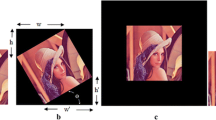Abstract
This paper proposes a solution for digital image copyright protection technique using the combination of watermarking and visual encryption technique. In our solution, the copyright information (copyright logo) is distributed into n shares using k − out − of − n distributed algorithm, also called (k, n) visual secret sharing method. One of the shares is randomly selected to embed into the original image to prove the user’s copyright. The remaining n − 1 shares is used to register with Copyright Department. When claiming the copyright belongs to the user, the verifier only needs to extract the watermark information from the watermarked image, then decodes with any registered k − 1 shares from n − 1 shares for restoring copyright information. Experimental results of the proposed method compared with the method using only digital watermark show that our method has more practical effectiveness in the application of digital product copyright protection.










Similar content being viewed by others
References
Abdelhedi K, Chaabane F, Ben Amar C (2020) A SVM-Based Zero-Watermarking Technique for 3D Videos Traitor Tracing, Advanced Concepts for Intelligent Vision Systems (ACIVS 2020), Lecture Notes in Computer Science, vol 12002. Springer, Berlin. https://doi.org/10.1007/978-3-030-40605-9_32
Barni M, Bartolini F, Piva A (2001) Improved wavelet-based watermarking through pixel-wise masking. IEEE Trans Image Process 10(5):783–791
Benoraira A, Benmahammed K, Boucenna N (2015) Blind image watermarking technique based on differential embedding in DWT and DCT domains. EURASIP Journal on Advances in Signal Processing, vol 55
Bolla VR, Gopal V, Amancha S (2016) A Two Phase Copyright Protection Scheme for Digital Images using Visual Cryptography and Sampling Meth161 ods. In: International Conference on Electrical Electronics, and Optimization Techniques (ICEEOT), pp 2041–2046
Cedillo-Hernandez M, Garcia-Ugalde F, Nakano-Miyatake M, Perez-Meana H (2014) Robust digital image watermarking using interest points and DFT domain. In: 35Th IEEE international conference on telecommunications and signal processing (TSP), pp 715–719
Cimato S, Yang JCN, Wu C (2014) Visual cryptography based watermarking, transactions on data hiding and multimedia security IX, 91–109
Das C, Panigrahi S, Sharma VK, Mahapatra KK (2014) A novel blind robust image watermarking in DCT domain using inter-block coefficient correlation. AEU Int J Electron Commun 68(3):244–253
Fu MS, Au OC (2004) Joint visual cryptography and watermarking. IEEE International Conference on Multimedia and Expo (ICME), 27–30
Hsu CT, Wu JL (1999) Hidden digital watermarks in images. IEEE Trans Image Process 8(1):58–68
Hwang RJ (2000) A digital image copyright protection scheme based on visual cryptography. Tamkang J Sci Eng 3(2):97–106
Joan D, Vincent R (2003) AES Proposal: Rijndael, National Institute of Standards and Technology. https://nvlpubs.nist.gov/nistpubs/FIPS/NIST.FIPS.197.pdf
Liu X, Zhao R, Li F, Liao S, Ding Y, Zou B (2017) Novel robust zero-watermarking scheme for digital rights management of 3D videos. Signal Processing Image Communication 54:140–151. https://doi.org/10.1016/j.image.2017.03.002. ISSN 0923–5965
Naor M, Shamir A (1995) Visual Cryptography. In: De Santis A (ed) Advances in Cryptology (EUROCRYPTO 94), (Lecture Notes in Computer Science), vol 950. Springer, Berlin, pp 1–12
Rani A, Bhullar AK, Dangwal D, Kumar S (2015) A Zero-Watermarking Scheme using Discrete Wavelet Transform. Procedia Computer Science 70:603–609. https://doi.org/10.1016/j.procs.2015.10.046. ISSN 1877–0509
Shamir A (1979) How to share a secret? Comm ACM 22(11):612–613
Singh AK, Dave M, Mohan A (2015) Robust and secure multiple watermarking in wavelet domain. J Med Imaging Health Inform 5(2):406–414
Singh AK, Dave M, Mohan A (2015) Hybrid technique for robust and imperceptible multiple watermarking using medical images. Multimed Tools Appl 121
Singh AK, Kumar B, Dave M, Mohan A (2015) Robust and imperceptible dual watermarking for telemedicine applications. Wirel Pers Commun 80 (4):1415–1433
Singh AK, Kumar B, Singh SK, Ghrera SP, Mohan A (2016) Multiple watermarking technique for securing online social network contents using Back Propagation Neural Network. Future Generation Computer Systems
Sun M, Fu OCA (2004) Joint visual cryptography and watermarking, 2004. IEEE International Conference on Multimedia and Expo (ICME) (IEEE Cat. No.04TH8763) 2:975–978
Surekha B, Swamy GN (2013) Sensitive digital image watermarking for copyright protection. Int J Netw Secur 15(1):95–103
Thanh TM, Hiep PT, Tam TM, New Spatial A (2014) Q-log Domain for Image Watermarking, IJIIP. International Journal of Intelligent Information Processing 5(1):12–20. ISSN 2093–1964
Thanh TM, Tanaka K (2014) A proposal of novel q-DWT for blind and robust image watermarking. In: Proceeding of IEEE 25th International Symposium on Personal, Indoor and mobile radio communications - (PIMRC). Washington DC, pp 2066–2070
Thanh TM, Tanaka K (2016) An image zero-watermarking algorithm based on the encryption of visual map feature with watermark information. In: International Journal of Multimedia Tools and Applications (MTAP). ISSN 1573–7721
Thanh TM, Tanaka K (2016) The novel and robust watermarking method based on q-logarithm frequency domain. Multimed Tools Appl 75:11097–11125
Tharayil JJ, Kumar ESK, SusanAlex N (2012) Visual cryptography using hybrid halftoning. Procedia Eng 38:2117–2123
Urvoy M, Goudia D, Autrusseau F (2014) Perceptual DFT watermarking with improved detection and robustness to geometrical distortions. IEEE Trans Inform Forens Secur 9(7):1108–1119
Wang MS, Chen WC (2007) Digital image copyright protection scheme based on visual cryptography and SVD. Opt Eng 6:46
Zear A, Singh AK, Kumar P (2016) A proposed secure multiple watermarking technique based on DWT, DCT and SVD for application in medicine. Multimed Tools Appl, 1–20
Acknowledgements
This research is funded by Vietnam National Foundation for Science and Technology Development (NAFOSTED) under grant number 102.01-2019.12.
Author information
Authors and Affiliations
Corresponding author
Additional information
Publisher’s note
Springer Nature remains neutral with regard to jurisdictional claims in published maps and institutional affiliations.
Rights and permissions
About this article
Cite this article
Thanh, T.M., Dan, G.N. Pseudo Zero-watermarking Technique based on non-blind watermarking and VSS. Multimed Tools Appl 81, 29119–29136 (2022). https://doi.org/10.1007/s11042-022-12079-9
Received:
Revised:
Accepted:
Published:
Issue Date:
DOI: https://doi.org/10.1007/s11042-022-12079-9




